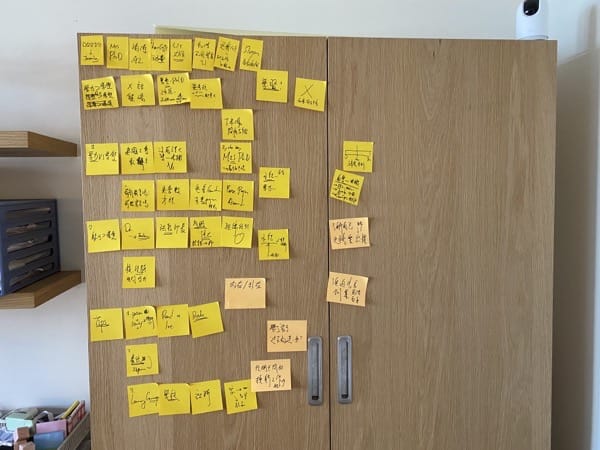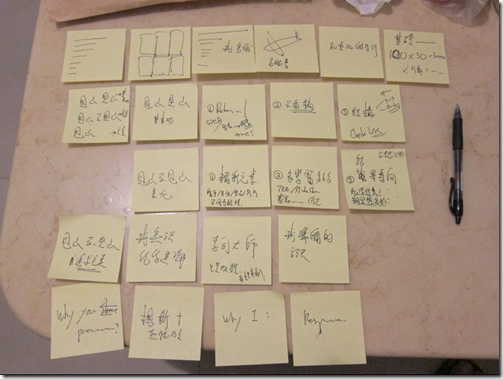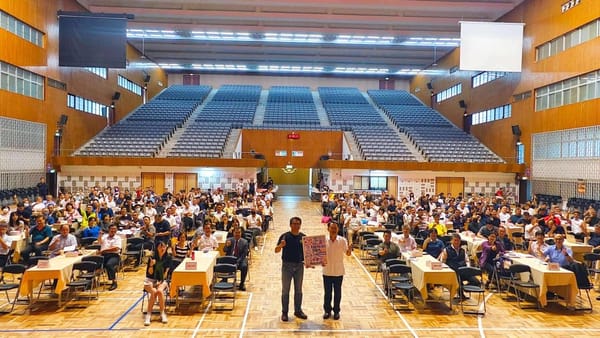What is My Doctoral Research About? Introduction to the Triangle Learning Theory – TLT"
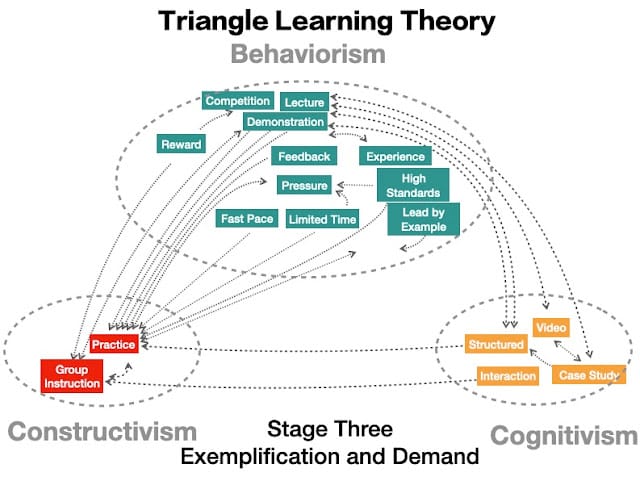
After 12 years of hard work, from enrolling in 1998 to now in 2022, from before my child was born to now they're in fourth grade and second grade. After all this time, I have finally passed my doctoral dissertation defense! 🎉
Full text of the doctoral dissertation available for download: "Exploring the Secrets of Corporate Trainers' Teaching through Variations in Learners' Cognitive Schemata." (Chinese Vesion)
"What exactly is this dissertation about?" I believe this may be a question on many people's minds.
This dissertation combines my practical experience in corporate teaching with learning theories. Through interviews with 12 respondents from four publicly listed companies, distilled from 160,000 words of interview transcripts, I identified 15 cognitive schemata (plainly put: key learning points in class) and 24 teaching schemata (plainly put: 24 common teaching techniques used by corporate trainers). Finally, I proposed the "Triangle Learning Theory" (TLT) for teaching techniques. During the defense, the committee highly praised the academic and practical aspects of this research. It truly took years of dedication and daily early morning work check-ins to complete this study...
However, I also understand that most people probably don't have the time (or patience) to read through the entire 400-plus-page dissertation (including interview transcripts). Academic research... especially doctoral dissertations, are meant to be detailed to demonstrate rigor in the process. But if we switch perspectives to a practical angle, the question becomes, "What are the results of this research? How can it benefit educators in general?"
Let's skip over all the research investigations and analysis process for now, and go straight to the conclusion: By applying the "Triangle Learning Theory (TLT)," you can check if any aspect is missing in your teaching process. Just by completing this golden triangle, you can make your teaching more effective! Students' learning outcomes will improve! There's a greater chance they'll remember what they've learned for a longer period!
"Is it really that effective? Can it be this useful?"
Triangle Learning Theory – TLT
The "Triangle Learning Theory – TLT" can be quickly explained as follows: Effective teaching requires the integration of three learning theories throughout the entire teaching process: behaviorism, cognitivism, and constructivism. This ensures that students absorb and retain knowledge more comprehensively and for a longer period.
For instance, after attending the "Professional Presentation Skills" course, many people are deeply impressed by the "sticky note brainstorming" technique. Some even remember and continue using it for years to come. Why is this? Is it because it's genuinely useful, or is there something special about our teaching method? Now, let's consider it from a different angle: If I just talk about how effective sticky note brainstorming is from start to finish, will students remember it for so long? If you only watch a video of me demonstrating the technique, will the impression be so enduring?
So, let's analyze in detail: the process of teaching the "sticky note brainstorming" technique in class (note that this Know-How is not disclosed). I start by "explaining" what the technique is (which falls under behaviorism), then break it down into four steps (structuring, which belongs to cognitivism). Next, I provide an example (analogous to case-based learning, which also belongs to cognitivism), and then demonstrate it on the spot (demonstration is part of social learning theory, also falling under behaviorism). Up to this point... this is the teaching process for the front part of the sticky note technique.
Did anyone notice: throughout the entire teaching process, the teaching method keeps alternating between "behaviorism" <> "cognitivism," using a blend of different teaching techniques...
Now, have you noticed which part is missing among the three major teaching techniques?
That's right, in addition to using "behaviorism" and "cognitivism," we should also apply "constructivism" to make the whole learning process complete! Therefore, after I finish the demonstration, we ask participants to practice on their own through "group discussions" (both group discussions and practice fall under constructivism). This way, you will see that the entire teaching process of the sticky note technique fully applies the teaching methods based on the three major learning theories: "behaviorism," "cognitivism," and "constructivism." This is how participants' learning becomes comprehensive, impressive, and long-lasting.
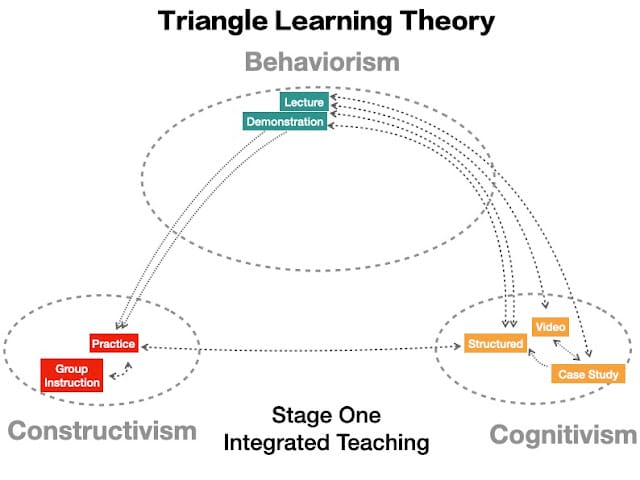
(Triangle Learning Theory, Stage One: Integrated Teaching)
The above explanation is not solely based on my own experience and insights, of course. This research primarily relies on the personal experiences of the participants. The study involved 12 participants from four publicly listed companies (spanning high-tech, finance, manufacturing, and other industries). Through interviews conducted before, immediately after, one month after, and two months after the course (12 participants x 4 interviews = 48 interviews!), it was found that the Sticky Note method was one of the most memorable learning experiences for everyone. Then, by meticulously analyzing the participants' responses (in academic terms, conducting grounded theory coding), it was discovered that the various teaching methods used left a profound impression on the participants two months after the course. After integrating practical experience, participant interviews, teaching techniques, and learning theory foundations, it was ultimately possible to formulate an effective learning approach by integrating the three major learning theories (in academic terms, establishing cognitive schemas for long-term memory retention). These three major learning theories can be synthesized into three stages: Stage One, Integrated Teaching; Stage Two, Stimulus Reinforcement; and Stage Three, Exemplification and Demand. By progressing from simple to complex, over 20 different teaching techniques can be derived from these stages.
Practical Application of TLT Theory
Here's another practical example of applying the theory: Recently, I served as an internal trainer and coach for a globally renowned Fortune 500 company. When I reviewed the courses designed by the instructors, I used the "Golden Triangle of Learning Theories" to evaluate and analyze the entire teaching process. For example, Teacher A relied solely on "lecturing" from start to finish, utilizing only the "Behavioral Theory" for teaching stimulation... and ended up being asked to redo the course XD.Teacher B was a bit better. The teaching process included both "lecturing" and presenting a "case study." This can be considered a more engaging teaching method, but ultimately, after listening, everyone still didn't know how to apply it. In other words, although it mixed "Behavioral Theory" and "Cognitive Theory," it didn't incorporate "Constructivist Theory." At this point, the knowledge or skills still belonged to the teacher, not the students. So, while they weren't asked to redo the course, they were asked to make modifications!Teacher C was more thoughtful. She understood that in addition to "lecturing" and presenting a "case study" to engage the students, she also needed to think about how to help students internalize the knowledge as a part of themselves (learning from Constructivist Theory). Therefore, after presenting the content and case study, she then required the students to engage in "practical exercises" (Constructivist Theory). She broke down the process into five major steps (structuring, belonging to Cognitive Theory), demonstrated it herself (Behavioral Theory), and finally had the students complete the practical exercise through "group discussions" (collaborative learning, belonging to Constructivist Theory). Throughout the entire teaching process, the teaching methods were constantly shifting between the three learning theory foundations, flowing smoothly. Ultimately, very positive teaching outcomes were achieved.
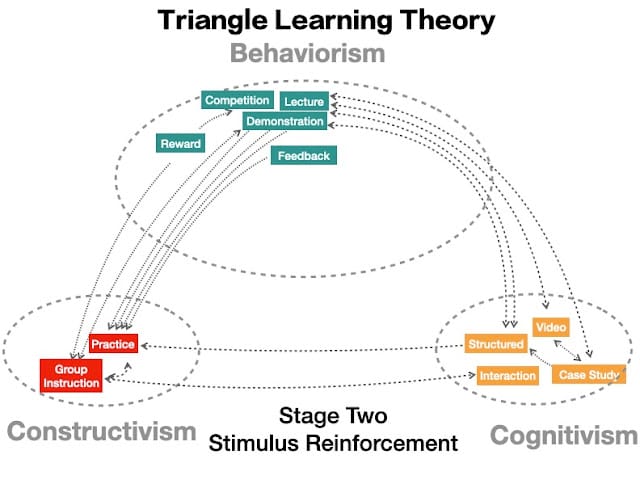
(Triangle Learning Theory, Stage Two: Stimulus Reinforcement)
Understanding the Reasons Behind Knowledge
The practical applications of these "Golden Triangle" examples were actually written in my blog back in 2018 (November 30th) and also appeared in the book "Teaching Techniques" as well as in online courses. So, it seems like I didn't need such a long research process, and I already knew these things...
However, in recent years, through the research process, I started from the practical aspects of teaching techniques, delving into the theoretical essence behind these techniques. I then looked at what students remembered after taking the class from the perspective of the learner. Why does teaching have an effect? I transitioned from understanding "what" (originally without formal learning of related learning theories, purely derived from practical experience) to understanding "why" (why do these methods work? Why can they help everyone remember?). By distilling theory from practice and deepening practice with theory, after understanding the reasons, when I look back at these teaching methods and designs, it's as if I've put on a lens. I can see the essence from the appearance and make guidance and responses quickly.
Most importantly, perhaps this research outcome will help everyone have better applications in teaching in the future. Theory is just a supplement, and there's no one-size-fits-all learning theory. Truly effective teaching design involves combining the golden triangle of learning theories, mixing different teaching methods, so that students not only understand and learn but also can do! In the future, you can use this simple analytical structure to look at your own teaching, to see where you're doing well and where you can do better.
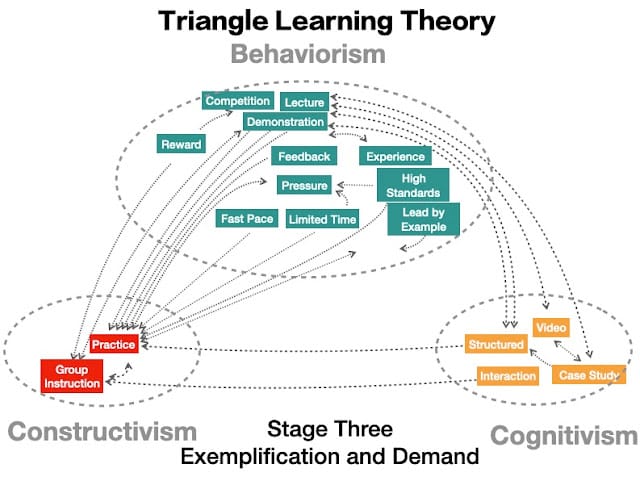
(Triangle Learning Theory, Stage Three: Exemplification and Demand)
Practical Experience, Academic Pursuits, and Output of Achievements
Looking back on my journey, I first honed my skills in corporate teaching (published in 2014 as "The Techniques of On-Stage Presentation"). Then, I delved into the realm of academic theory in 2018, initiating the process of writing my doctoral thesis. Subsequently, I consolidated my teaching experiences and published "The Techniques of Teaching" in 2019. Concurrently, I continued to link my teaching experiences with academic research and learning theories.
In January 2020, I successfully passed the research proposal review, paving the way for interviews with participants from listed companies. However, this endeavor was met with the challenges posed by the pandemic. Then, in June 2020, I launched the "Techniques of Teaching - Online Course." In August 2021, I authored "Techniques of Online Teaching." Additionally, I transformed the gamification elements used in the course into a thesis, which was accepted by an SCI journal in October 2021.
Throughout this process, I persistently worked towards completing my doctoral thesis research. I sought to understand the secrets behind corporate trainer instruction from the perspective of learners' cognitive schema variation. Finally, at the end of January 2022, I successfully defended my doctoral thesis.
With 14 years of practical experience as a corporate trainer and 3 years as a part-time university lecturer, coupled with academic endeavors including a doctoral thesis in instructional research and publication in a gamified SCI journal, along with authored works such as "The Techniques of Teaching," "Techniques of Online Teaching," "On-Stage Techniques," and "Techniques of Audiovisual Teaching - Online Course," and my previous experience guiding and assisting many teachers as their instructional coach, I believe that the "Triangle Learning Theory (TLT)" I propose can help everyone teach more effectively and ensure students have a more fruitful learning experience. This has been my enduring commitment and motivation to complete this research!

